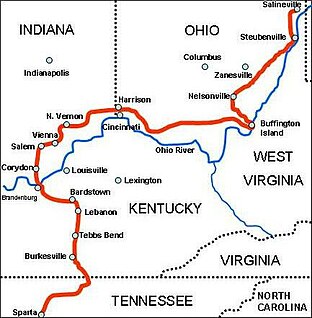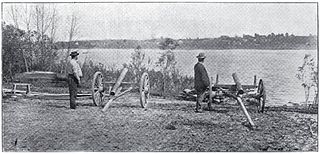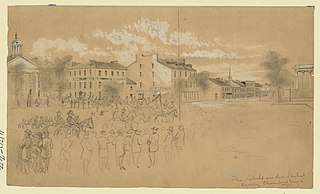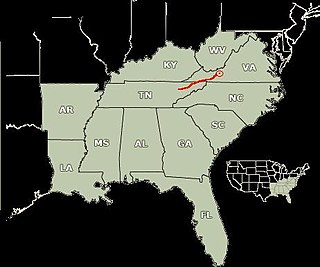 W
WThe Beefsteak Raid was a Confederate cavalry raid that took place in September 1864 as part of the Siege of Petersburg during the American Civil War. Confederate Maj. Gen. Wade Hampton led a force of 3,000 troopers of the Confederate States Army on what was to become a 100-mile (160 km) ride to acquire cattle that were intended for consumption by the Union Army, which was laying a combined siege to the cities of Richmond and Petersburg, Virginia.
 W
WThe Burning Raid was a Union war crime conducted in the Loudoun Valley of Loudoun and Fauquier counties in Virginia in November and December 1864 during the American Civil War. It was aimed at destroying the forage on which Confederate partisans operating in the area, specifically Mosby's Rangers, subsisted as well as at breaking the will of the citizens of the area for supporting the partisans.
 W
WThe Second Battle of Cynthiana included three separate engagements during the American Civil War that were fought on June 11 and 12, 1864, in Harrison County, Kentucky, in and near the town of Cynthiana. This was part of Confederate Brigadier General John H. Morgan's 1864 Raid into Kentucky. The battle ultimately resulted in a victory by Union forces over the raiders and ended Morgan's Last Kentucky Raid in defeat. Morgan's command had previously captured the town in the First Battle of Cynthiana, July 17, 1862.
 W
WThe Battle of Day's Gap, fought on April 30, 1863, was the first in a series of American Civil War skirmishes in Cullman County, Alabama, that lasted until May 2, known as Streight's Raid. Commanding the Union forces was Col. Abel Streight; Brig. Gen. Nathan Bedford Forrest led the Confederate forces.
 W
WThe Battle of Droop Mountain was a battle in Pocahontas County, West Virginia, that occurred November 6, 1863, during the American Civil War. Confederate forces under Brigadier Generals John Echols and Albert G. Jenkins engaged, but failed to prevent, Union forces under Brigadier General W.W. Averell and Colonel Thomas M. Harris from a rendezvous with other Federal troops in a joint raid on Confederate railways. Droop Mountain was one of the largest engagements in West Virginia during the war. As a result of the Union victory, Confederate resistance in the state essentially collapsed.
 W
WGilmor's Raid, also known as The Magnolia Station Train Raid, was a foraging and disruptive cavalry raid that was part of an overall campaign against Union railroads, led by Maj. Harry W. Gilmor with 135 men from the First and Second Maryland Cavalry regiments. It was authorized by Confederate Lt. Gen. Jubal Early during his Valley Campaigns of 1864, which threatened Washington, D.C., during the American Civil War.
 W
WGrierson's Raid was a Union cavalry raid during the Vicksburg Campaign of the American Civil War. It ran from April 17 to May 2, 1863, as a diversion from Maj. Gen. Ulysses S. Grant's main attack plan on Vicksburg, Mississippi.
 W
WThe Hines' Raid was a Confederate exploratory mission led by Thomas Hines, on orders from John Hunt Morgan, into the state of Indiana in June 1863 during the American Civil War. Hines' mission was to prepare the groundwork of Morgan's Raid across the Ohio River into Indiana and Ohio by seeing what support the local Knights of the Golden Circle and Copperheads would provide for the main operation.
 W
WMorgan's Raid was a diversionary incursion by Confederate cavalry into the northern (Union) states of Indiana, Kentucky, Ohio and, briefly, West Virginia, during the American Civil War. The raid took place from June 11 to July 26, 1863, and is named for the commander of the Confederate troops, Brig. Gen. John Hunt Morgan. Although it caused temporary alarm in the North, the raid was ultimately classed as a failure.
 W
WOn March 17, 1863, Captain John Singleton Mosby "The Gray Ghost" raided a union outpost at Herndon Station in Northern Virginia. The raid was a part of a series of such raids coordinated by confederate Captain Mosby and his raiders in 1863 in areas of Northern Virginia. The raid on Herndon Station was the furthest north into Union lines Mosby and his men ventured. During the raid of Herndon Station 25 Union picket men were captured, and four Union men having lunch at the home of Herndon resident Kitty "Kitchen" Hanna were also found and captured by Mosby's raiders. The Town of Herndon still remembers the raid to this day as an important part of the town's history and participation in the Civil War.
 W
WThe Newburgh Raid was a successful raid by Confederate partisans on Newburgh, Indiana, on July 18, 1862, making it the first town in a northern state to be captured during the American Civil War. Confederate colonel Adam Rankin Johnson led the raid by using a force of only about 35 men he had recruited from nearby Henderson, Kentucky. They confiscated supplies and ammunition without a shot being fired by tricking Newburgh's defenders into thinking the town was surrounded by cannons. In reality, the so-called cannons were an assemblage of a stove pipe, a charred log, and wagon wheels, forever giving the Confederate commander the nickname of Adam "Stovepipe" Johnson.
 W
WThe Battle of Pine Bluff, also known as the Action at Pine Bluff, was a battle of the American Civil War. The battle was fought on October 25, 1863, in Jefferson County, Arkansas, near the county courthouse, where the U.S. garrison under the command of Col. Powell Clayton successfully defended the town against attacks led by Confederate Brig. Gen. John S. Marmaduke. The Union victory ensured the safety of the garrison until the end of the war.
 W
WPrice's Missouri Expedition, also known as Price's Raid or Price's Missouri Raid, was an unsuccessful Confederate cavalry raid through the states of Arkansas, Missouri, and Kansas in the Trans-Mississippi Theater of the American Civil War. Led by Confederate Major-General Sterling Price, the campaign's intention was to recapture Missouri and renew the Confederate initiative in the larger conflict.
 W
WThe Raid on Chambersburg, often identified as J.E.B. Stuart's Chambersburg Raid, was a Confederate States Army cavalry raid into Maryland and Pennsylvania on October 10–12, 1862 during the American Civil War. It became known as Stuart's "second ride around McClellan" because it duplicated Stuart's reconnaissance ride completely around the Union Army of the Potomac under Major General George B. McClellan during the ill-fated Peninsula Campaign.
 W
WShelby's Raid was an 1863 Confederate cavalry raid from Arkansas into Missouri during the American Civil War. It had not been a good year for the Confederates in Arkansas with several setbacks. These included the loss of Little Rock the state capital, Fort Hindman, and the failure to retake Helena. Colonel Joseph Shelby thought that a fast moving raid could boost morale, acquire recruits, and keep federal troops busy so they couldn't assist in Northern operations elsewhere. His troops fought numerous skirmishes and caused a deal of disruption in Missouri, making it as far north as Waverly, Missouri, before withdrawing to Arkansas. This raid cemented Shelby's reputation as a cavalry commander and made plain that Missouri was still vulnerable to this kind of cavalry raid.
 W
WThe Sinking Creek Raid took place in Greenbrier County, Virginia during the American Civil War. On November 26, 1862, an entire Confederate army camp was captured by 22 men from a Union cavalry during a winter snow storm. The 22 men were the advance guard for the 2nd Loyal Virginia Volunteer Cavalry, which was several miles behind. This cavalry unit was renamed 2nd West Virginia Volunteer Cavalry in 1863, after West Virginia became a state.
 W
WStoneman's 1864 raid also known as Stoneman's raid into Southwest Virginia was an American Civil War expedition into southwest Virginia by Cavalry and Infantry regiments, including the 3rd North Carolina Mounted Infantry, under Union Maj. Gen. George Stoneman, designed to disrupt infrastructure beneficial to the Confederate war effort. This expedition resulted in the Battle of Marion and the Second Battle of Saltville against a Confederate force under the command of John C. Breckinridge and accomplished the destruction of the saltworks at Saltville, Virginia.
 W
WStoneman's raid in 1865 was a military campaign in the American Civil War by Union cavalry troops led by General George Stoneman which began on March 23, 1865, in Knoxville, Tennessee. The Union soldiers were tasked with orders to "dismantle the country". They headed east into North Carolina destroying towns and plundering along the way, then headed north into Virginia on April 2 where they destroyed 150 miles of railroad track belonging to the Virginia & Tennessee Railroad. They re-entered North Carolina on April 9 and traveled south to the twin towns of Winston and Salem, now Winston-Salem, and then onward to High Point.
 W
WStreight's Raid took place in northern Alabama during the American Civil War. It was led by Union Army Col. Abel Streight and opposed by Confederate Brig. Gen. Nathan Bedford Forrest. Streight's goal was to destroy parts of the Western and Atlantic Railroad, which was supplying the Confederate Army of Tennessee. The raid was poorly supplied and planned, and ended with the defeat of Streight and his 1,700 men at Cedar Bluff, Alabama, by Forrest who bluffed his opponent into surrendering to his 500 men. Streight was additionally hindered by locals throughout his march, while pursued by Forrest, who had the advantage of home territory and the sympathy and aid of the local populace, most famously Emma Sansom.
 W
WThe Warrenton Junction Raid was a surprise attack by Confederate guerrilla warriors on a Union cavalry detachment during the American Civil War. The raid took place near a railroad junction in Virginia's Fauquier County, less than 10 miles (16 km) from the town of Warrenton. Confederate Major John S. Mosby led the attack against about 100 men from the Union's 1st (West) Virginia Cavalry. At first, the raid was very successful, as many of the Union soldiers surrendered to the rebels. The remaining portion of the surprised force was surrounded in a house, and two of their leaders were wounded. The house was set on fire, and the Union soldiers surrendered. As Mosby's men rounded up prisoners and horses, a detachment of the 5th New York Cavalry surprised the rebels and rescued most of the captured Union soldiers. After a short fight, more men from the 5th New York, and the 1st Vermont Cavalry, joined in the pursuit of Mosby's fleeing rebels.
 W
WWheeler's October 1863 Raid was a large cavalry raid in southeastern Tennessee during the American Civil War. Maj. Gen. Joseph Wheeler's Confederate cavalry scored a great initial success, but subsequently was roughed up by Union cavalry during its withdrawal south of the Tennessee River.
 W
WThe Wilson–Kautz Raid was a cavalry operation in south central Virginia in late June 1864, during the American Civil War. Occurring early in the Richmond-Petersburg Campaign, the raid was conducted by Union cavalry under Brigadier Generals James H. Wilson and August Kautz, who were ordered to cut railroads between Lynchburg, Virginia, and the vital Confederate rail supply center at Petersburg. While the raid had the intended effect of disrupting Confederate rail communications for several weeks, the raiding force lost much of its artillery, all of its supply train, and almost a third of the original force, mostly to Confederate capture.
 W
WThe Wytheville Raid or Toland's Raid was an attack by an undersized Union brigade on a Confederate town during the American Civil War. Union Colonel John Toland led a brigade of over 800 men against a Confederate force of about 130 soldiers and 120 civilians. The location of Wytheville, the county seat of Wythe County in southwestern Virginia, had strategic importance because of a nearby lead mine and the railroad that served it. This mine supplied lead for about one third of the Confederate Army's munitions, while the Virginia & Tennessee Railroad transported Confederate troops and supplies; plus telegraph wires along the railroad line were vital for communications. In addition to logistics of moving the lead to bullet manufacturing facilities, this rail line also connected an important salt works of an adjacent county with the wider Confederacy.